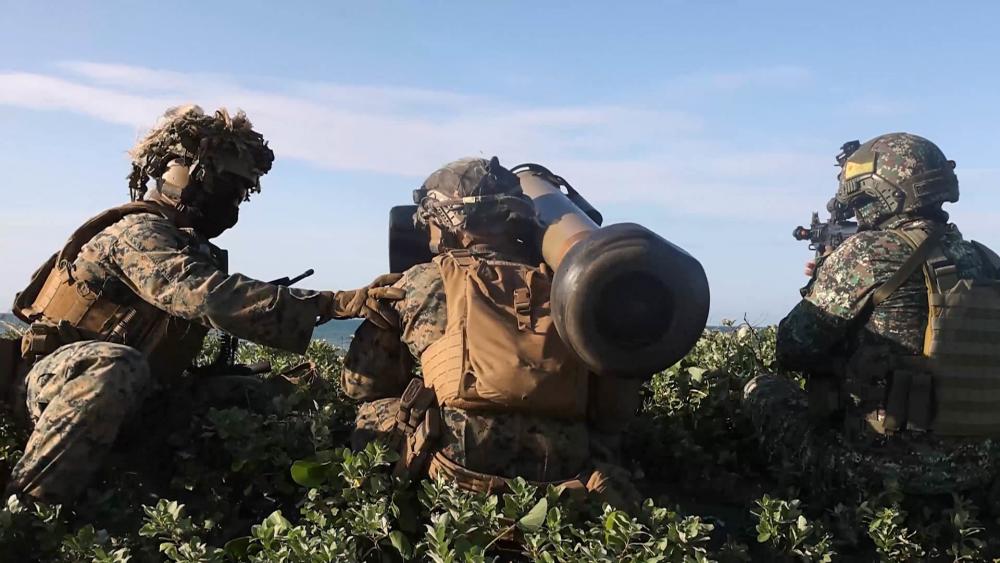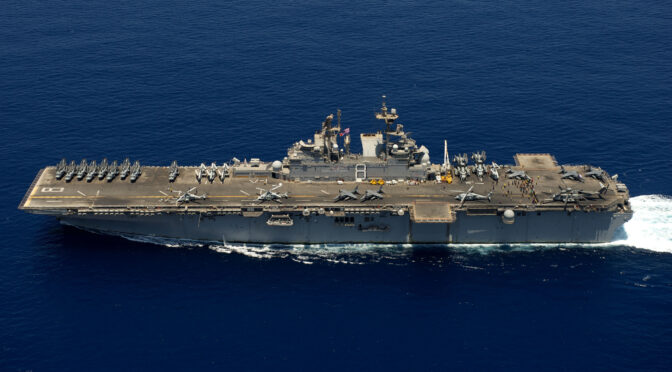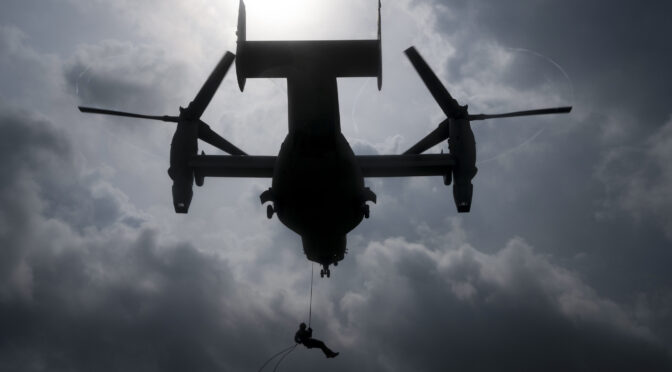Transforming the Marine Corps Topic Week
By Brent Stricker
The ongoing transformation of the U.S. Marine Corps has raised some controversy and prompted wide-ranging discussions on the future of the Corps. Opponents of Expeditionary Advanced Base Operations, or EABO, are concerned that proven combat power like tanks and tube artillery, are being sacrificed to create a new force that is less flexible, and would provide a single tool fit for only one operational problem. EABO and the Marine Littoral Regiment (MLR) are supposed to be an answer to the Anti-Access/Area Denial (A2/AD) strategy of the People’s Republic of China (PRC). EABO is best understood as a virtual network of scout snipers extending the eyes and fires of the fleet. Marines, operating as Stand-in Forces, will hide in the littoral spaces inside an enemy’s Weapons Engagement Zone or “WEZ,” where they can support a friendly fleet that has to remain outside the WEZ. These forces will also rely on use deception and signature management, displacing every 48 to 72 hours using high-speed, low signature craft and use decoys that an enemy will struggle to target. Critics have also argued that TMEABO abandons the Marines Corps’ fundamental doctrine as described in MCDP-1 Warfighting. But this ignores the warnings of General Alfred M. Gray, 29th Commandant of the Marine Corps, in the preface to MCDP-1: “Like war itself, our approach to warfighting must evolve. If we cease to refine, expand, and improve our profession, we risk becoming outdated, stagnant, and defeated.” EABO is firmly based in the tenants of maneuver warfare where speed, surprise, deception, and ambiguity are essential. Preliminary doctrine for this force has been laid out in the Tentative Manual for Expeditionary Advanced Base Operations, or TMEABO, a publication that pays homage to the Tentative Manual for Landing Operations—and a previous effort to remake the Marine Corps for amphibious warfare during the interwar years.
Despite the breadth of conversation surrounding EABO, operational law has been largely ignored in the discussions, by both critics and proponents of the new concept. As the U.S. Marine Corps develops and transforms its doctrine for EABO, it must consider what impacts international law will have on future operations. Key factors to consider include targeting, degraded logistics, deception plans, and territorial access.
Targeting
EABO will see the Marine Corps embrace a new form of targeting, particularly when integrated with the Navy. In the past, Marines were concerned with targeting military objectives on land, while limiting collateral and incidental damage to civilians and civilian objects. EABO will see Marines engaging naval platforms, like enemy submarines and warships, where the make-up of the vessel’s crew is irrelevant in the targeting process.
The Commander’s Handbook on the Law of Naval Operations provides a concise reference for the law concerning targeting such platforms. During conflict, enemy warships, naval auxiliaries, and military aircraft may be attacked or captured anywhere outside neutral territory without warning. Attacks on surface ships must cease when they have indicated an intention to surrender such as striking their colors, stopping, or surfacing if a submarine. A submerged submarine or disabled aircraft are subject to attack until destruction due to the uncertainty of surrender.
Enemy merchant vessels and civil aircraft are subject to capture outside neutral territory. They may be attacked if they are engaged in belligerent acts or conduct war-sustaining/war-supporting activity. If they actively resist visit and search or capture, persistently refuse to heave to after being ordered to do so, convoy with enemy warships, or are armed with weapons greater than needed for self-defense from pirates or terrorists, they may be attacked. In such case, enemy merchant vessels and civil aircraft are not innocently employed and they risk destruction.
Some enemy vessels may not be attacked or captured. Enemy hospital ships and medical aircraft may not be attacked, but they must be appropriately marked and registered. Other vessels are also immune based on their use. This status could include ships involved in prisoner exchange, or religious, scientific, or philanthropic use. Finally, small coastal vessels engaged in local fishing are immune from attack.
Contested Logistics
Marine Stand-In Forces will not be able to rely on a global supply chain and may be forced to subsist off the civilian infrastructure of a host nation or what may be seized from the enemy. As the Marine Corps develops new doctrine for EABO, it will need to consider how to requisition property in a host nation or in occupied enemy territory.
The initial question is where the property to be acquired is located, in host nation or enemy territory? In host nations, the Marine Corps will use local contractors and venders through contracting officers and purchase agents. If local property is seized or damaged, a Foreign Claims Agent will step in to pay compensation.
In the past, invading armies have foraged for their supplies. This allowed for the seizure of food and livestock to support an invading army. During the American Civil War, for example, the Lieber Code made a distinction between private and public property. Public property could be seized and used by the invading army. Private property was protected and could be seized only when military necessity required it. Even in such case, the property owner was entitled to fair compensation.
The 1907 Hague IV Convention for Land Warfare expanded the protection of both private and public property. In addition to a prohibition on destruction, unless required by military necessity, compensation was expected for damage or destruction. Hague IV also addressed the use of property during an occupation by a foreign power. An occupying army was only permitted to requisition property for its needs and the items taken had to be proportionate to the ability of the locality to provide them. Civilians were expected to be compensated in cash or issued a receipt.
The Hague Regulations were supplemented or superseded with four Geneva Conventions in 1949: 1. GC I (Wounded and Sick in the Field) ; 2. GC II (Wounded, Sick, and Shipwrecked at Sea) ; 3. GC III (Prisoners of War); and GC IV (Civilians). Article 34 of GC I notes that aid societies’ property be treated as private and subject to requisition only in “case of urgent necessity” and after the wounded and sick have been cared for.
GC III also makes a distinction between requisition of private and public property. Article 18 of GC III notes that POWs have the right to retain personal property including clothing, feeding utensils, and protective equipment. This was felt necessary because during the Second World War, many POWs were stripped of personal property and their issued equipment. This was an incorrect interpretation of a belligerent’s right to seize an enemy’s public property.
Since the right of requisition is tied to occupation of enemy territory, a discussion of what constitutes occupation is necessary. The 2016 Commentary to Article 34 of GC I notes occupation does not begin at the front lines. Article 42 of Hague IV defines occupation as control of territory. The DOD Law of War Manual requires that the occupation be actual, effective, and the territory must be under the authority of the hostile army.
GC IV (Civilians) placed certain obligations on an occupying power toward the civilian population. Article 55 discusses the obligation to provide food and medical supplies to civilians. Requisition may only be used to support the occupying force, not the war effort. If requisition does occur, compensation must be paid, and requisitions must consider the needs of the civilian population. The 1958 Commentary to Article 55 and Article 147 label excessive requisitioning a grave breach of the convention subject to prosecution as a war crime.
The Commander’s Handbook on the Law of Land Warfare provides a summary of the U.S. policy on protecting public and private property. It prohibits pillaging and the destruction of property “unless imperatively demanded by the necessities of war.” It notes that requisition may occur, but only in occupied areas and with the use of receipts and compensation.
Deception and Distinction to Protect Civilians
EABO relies on deception to ensure the survivability of Marines. The Stand-in Forces guidance suggests the use of civilian infrastructure to achieve this by using civilian vessels, vehicles, and civilian communication infrastructure. This deception plan must be balanced against the requirement to protect civilians and civilian objects. This principle is known as distinction where the law recognizes the protected status of civilians and civilian property from that of combatants and military objectives.
GC IV and Additional Protocol I represent what many countries accept as customary international law. The United States’ position on protected persons and places is contained in the DOD Law of War Manual and the Commander’s Handbook on the Law of Land Warfare. These publications note that commanders “must take feasible precautions to reduce the risk of harm to protected persons and objects” and to separate civilians from military operations where possible. Similar principles appear in Article 57 and Article 58 of AP I.
Any deception plan must be balanced with these requirements. Marines operating in and among the civilian population must ensure that they are distinct from noncombatants and do not place noncombatants at risk. Article 58(b) of AP I requires the parties to the conflict to avoid locating military objectives within or near densely populated areas. Moreover, the use of human shields is expressly prohibited by U.S. Policy and Article 51(7) of AP I.
The plan must also avoid perfidy. Marines may not employ a deception plan that leads the enemy to believe the Marines have a protected status. Perfidy is defined in Article 37 of AP I, the DOD Law of War Manual, and Commander’s Handbook on the Law of Land Warfare. Examples include the use of symbols of protected organizations, such as the International Red Cross; pretending to be a non-combatants, feigning surrender the use of flags of a neutral country. At sea, however, false flag operations are permitted until such time as naval combat is undertaken. For example, if Marines employ the Light Amphibious Warship, the law of naval warfare would allow the use of a false flag until hostilities commence.
Territorial Access
The Stand-in Forces guidance envisions the Marines defending the territory of an allied nation. EABO does not exclude seizing hostile territory, but it is more likely that the EABO A2/AD strategy will be used on a host nation’s territory in collective self-defense. The issue of access to this territory is key, and the stakes in international law are quite high. States exercise and enjoy sovereignty over their national territory and the territorial sea and the airspace above the land and the territorial sea.
East China Sea
The 1960 Japan-U.S. Security Agreement establishes a U.S. defense obligation to protect Japan and U.S. in Japan. Cooperation with Japan’s Self Defense Force must consider its limited authority. Article 9 of the Japanese Constitution was written to renounce war and the threat or use of force to resolve international disputes. A 2014 Japanese Cabinet Decision and the passing of the Armed Attack and Existential Crisis Situations Act potentially allows for Japan to act in what might be considered collective self-defense with the United States or another country when the situation poses a threat to Japan. The government has described three potential scenarios for the use of force: an anticipatory armed-attack, an actual armed attack, and an existential threat to Japan by an attack on a closely allied nation. This third scenario would likely include an attack upon the United States that threatens the U.S. ability to defend Japan. A crisis concerning Taiwan also might give rise to such a situation.
Security ambiguity is at the heart of U.S. policy toward Taiwan. Under the 1979 Taiwan Relations Act, the United States is authorized to provide Taiwan with weapons sufficient for Taiwan’s self-defense. The Act makes no commitment to defend Taiwan only stating an expectation that the One China policy must be peacefully resolved. Nonetheless, the United States would consider any effort to determine the future of Taiwan by other than peaceful means a threat to the peace and security of the Western Pacific area and of grave concern to the United States.
If the People’s Republic of China invaded or were preparing to invade Taiwan, both Japan and the United States may be drawn into the conflict. Japan exercises sovereignty and control of the Senkaku Islands adjacent to Taiwan. This claim is disputed by both the PRC and Taiwan. The United States acknowledges that its defense commitment extends to the Senkaku Islands under the administration of Japan. If an invasion crisis emerges in the region, the Marines may establish EABs on the Senkaku Islands to defend or deter aggression against the Ryukyu Islands or Japan proper. The inherent threat to U.S. forces in Japan would likely draw the Japanese Self Defense Forces into taking measures in concert with U.S. forces for collective self-defense.
South China Sea
The most likely country to allow the Marines ashore in the South China Sea is the Philippines. U.S.-Philippines relations have been turbulent dating back to the Philippine-American War when the United States invaded, and colonized the Philippines. Cold War pressures led to the Mutual Defense Treaty between the United States and the Philippines which provided for mutual support if there was an attack on the territory of either of the parties, island territories under their jurisdiction in the Pacific Ocean, or their armed forces, public vessels, or aircraft in the Pacific. The end of the Cold War and growing anti-American sentiment led the Philippine government to reject renewing a basing agreement and all U.S. forces were removed from the Philippines in the early 1990s. The subsequent Global War on Terror and continued bi-lateral training missions have seen U.S. forces return. U.S. service members are governed by the Visiting Forces Agreement (VFA), which has been a football in Philippine national politics. It was renounced by Philippine President Rodrigo Duterte on February 11, 2020 only to be reinstated July 30, 2021. Nonetheless, under the VFA, U.S. personnel may only be temporarily in the Philippines in connection with activities approved by the Philippine government.
The ability of Marine forces to access key maritime terrain in the Pacific will ultimately be determined by diplomacy and legal agreements. Every country will weigh its own diplomatic, economic, and defense requirements before granting access to US forces. As events unfold in the struggle of competition, to crisis, to conflict, new partners may emerge and old ones may fall away.
Conclusion
The future codification and operationalization of EABO will be constrained by international law. Marines will have to adapt their targeting to a new missions which target platforms and not individuals. Degraded and contested logistics will increase the demands on purchasing and contract agents. Deception plans will be forced to consider the obligation to protect civilians. EABO will be conducted in cooperation with host nation forces granting access in collective self-defense. Ultimately, EABO is a transformational warfighting concept that requires careful input by legal advisers and USMC judge advocates to ensure it unfolds consistent with international law and U.S. policy.
LtCol Brent Stricker, U.S. Marine Corps, serves as the Director for Expeditionary Operations and as a military professor of international law at the Stockton Center for International Law at the U.S. Naval War College.
The views presented are those of the author and do not necessarily reflect the policy or position of the U.S. Marine Corps, the U.S. Navy, the Naval War College, or the Department of Defense.
Featured Image: U.S. Marine Corps Lance Cpl. Stephen Mathews, a Liberty, Indiana native, and rifleman with 3d Battalion, 3d Marines conducts a combat patrol during Bougainville III at Marine Corps Training Area Bellows, Hawaii. (U.S. Marine Corps photo by Cpl. Patrick King)





